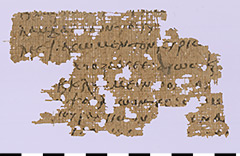P. 16595
Music without notation? Hard to imagine. But even when notes were not yet developed, people wanted to be able to write down musical instructions. One example of this is the duplication of vowels that can be found in this text written in Greek with content inspired by the New and Old Testaments.
The papyrus fragment was inscribed on the recto and verso with eight lines each, however, neither the author nor the origin is known, but it can be said with certainty that the piece can be dated to the 6th-7th century AD on the basis of the letter forms. Unfortunately, the condition of the fragment is not very good; it is only fragmentarily preserved and heavily perforated. The grammar as well as the orthography of the text is very poor. The papyrus is probably a unique piece. The hymn is written in a common, strong script, inclined to the right, and individual letters have been emphasized.
The text consists of two hymns. On the front, the baptism of Jesus in the River Jordan is described, using the Gospel of John as a model for the order of words. According to the Bible, the baptism of Jesus was performed by John the Baptist in the river Jordan. After the baptism, the Spirit of God is said to have come down from heaven like a dove and spoke to them. The last lines are no longer present, or even more perforated than the rest of the papyrus fragment, so that one can only speculate whether the text continues the biblical narrative, and if so, then probably in a very freely adapted version.
On the back of the papyrus, inspired by the Old Testament, is a triumphal song of the prophetess Miriam after the destruction of the pharaonic army and the escape of the Israelites through the Red Sea. This text differs even more from the text in the Bible than the readable part of the other page. The prophetess Miriam was an important personality of the Old Testament, who led the singing of the women and the dance of joy after the escape from Egypt by crossing the Red Sea. She is said to have been the sister of Moses. The text is supposed to represent the triumphal song, which the prophetess sang after the successful flight of the Israelites from Egypt. The escape was only successful, because Miriam’s brother Moses divided the Red Sea and thus drowned the army of Pharaoh.
The texts are most likely related to each other, with the sequence probably starting with the recto, the baptism of Jesus, and then the triumphal song, the verso. It is quite possible that the two texts are parts of a longer hymn. In any case, it can be said that the texts were sung or at least melodically or rhythmically performed, since double vowels are used as a model for a song. Such a duplication of vowels indicates where several notes come on a syllable. The singer, presumably a clergyman, probably knew the sequence of notes by heart and used the duplication only as a clue for him. This piece is one of the few in which musical duplication of vowels occur, so it is a particular pity that it is so badly preserved.
Today, the piece can be found on the ground floor of the Neues Museum in Berlin.



